In recent years, zero-waste trends have been booming. Various decoration ideas have thus emerged, recycling everyday objects. Among them is the star of upcycling: the famous wooden pallet. With its raw, natural look, it can be used to make garden furniture, a composter and even a pallet vertical garden. Moreover, this vertical garden is easy to make, economical and highly decorative. It creates a cascade of greenery at low cost or hides an unsightly wall. Discover how to make a pallet planter with our tutorial.

An unsightly concrete-block wall disappears behind planted pallets to create a small relaxation corner
Where to find pallets?
It is quite easy to recover pallets for free from professionals. Indeed, some shops or tradespeople often have pallets they no longer need. Just ask if you can have them.
Note: some pallets are consigned. These are mainly pallets stamped "EUR EPAL". In that case, it is rather rare that a company or shop can give them away. Also, these pallets are usually very heavy, but withstand weather a little longer.
Pallets can also be found on construction sites. In that case, ask the site manager for permission before taking them. Be careful: construction sites are dangerous and usually off-limits. Again, ask permission to avoid problems.
You can also check with your recycling centre or with friends and family.
Ingrid’s tip: For mounting at height, I prefer to use a lightweight, non-consigned pallet, which is easier to handle.
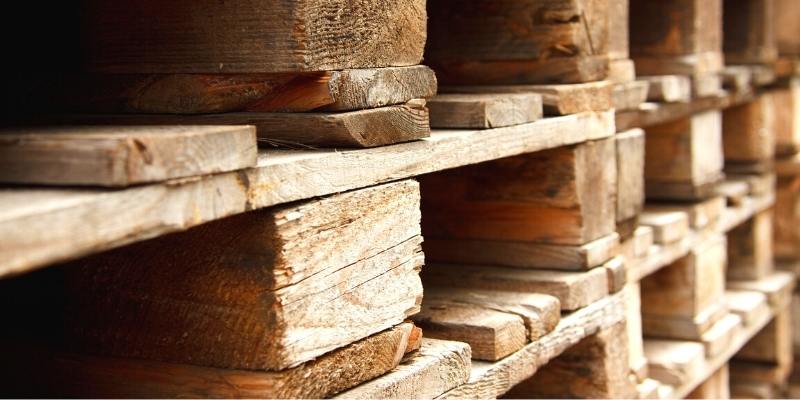
Recycled wooden pallets can be used to make furniture, garden lounge sets, boxes and vertical planters.
How to make a pallet vertical garden?
What do I need?
- A pallet
- Materials to fix pallet to wall (drill, wall plugs, screws and screwdriver)
- An upholstery stapler or a hammer and nails
- Potting compost
- A woven weed-control fabric or supermarket carrier bags
- Scissors or a craft knife for cutting
- Plants (we will see which to choose below)
- Facultative :
- Clay pebbles
- Garden gloves
- A crowbar if you want to remove some boards
Step-by-step construction of pallet green wall:
1 - Put on garden or work gloves to avoid splinters when handling wooden pallet.
2- Inspect pallet and choose how you want to position it. It can be placed vertically or horizontally, front-facing or back-facing. Choice is yours.
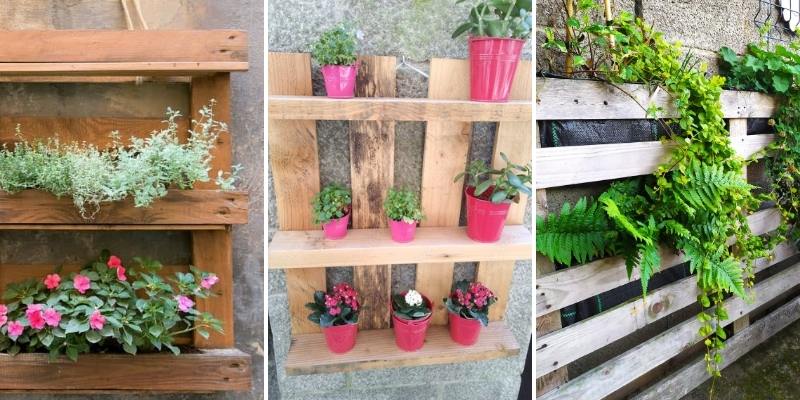
Depending on pallet orientation, visual effect differs
3- If you plan to paint pallet later, take time to sand it before starting. You can also remove unnecessary boards with a crowbar.
4- Fix pallet securely to wall.
5- Create a pocket to hold compost: measure space that will receive plants. Add 30 cm to measurements, then cut a rectangle from woven weed-control fabric. In a spirit of reuse, replace this fabric with supermarket carrier bags or simply an old piece of cloth.
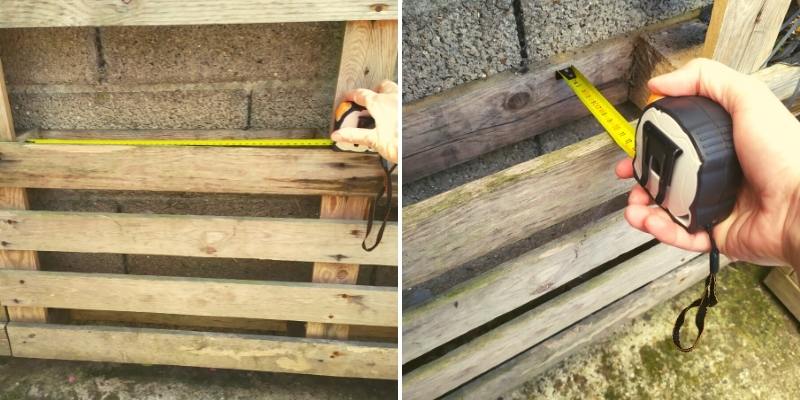
Take measurements and add 30 mm to dimensions
6- Attach fabric to pallet using an upholstery stapler or with a hammer and small nails. Start at back, then place base and finally secure front.
Tip: before fixing, fold fabric edge over itself to prevent fraying.
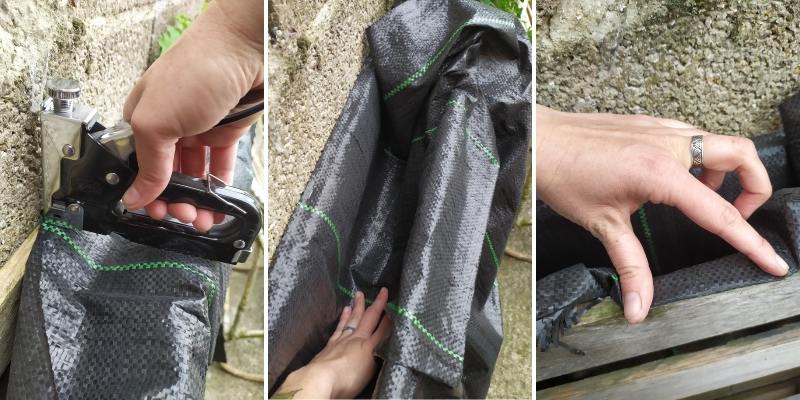
Fix fabric to back of pallet, then place base. Then fix front by folding fabric.
7- If pocket is waterproof, drill 3 to 4 holes in base, then pour a layer of clay pebbles. Fill then pocket halfway with potting compost suitable for your plants.
8- Remove plants from pots, then install plants and top up with compost to within 2 cm of edge.
9- Water plants thoroughly, preferably with rainwater.
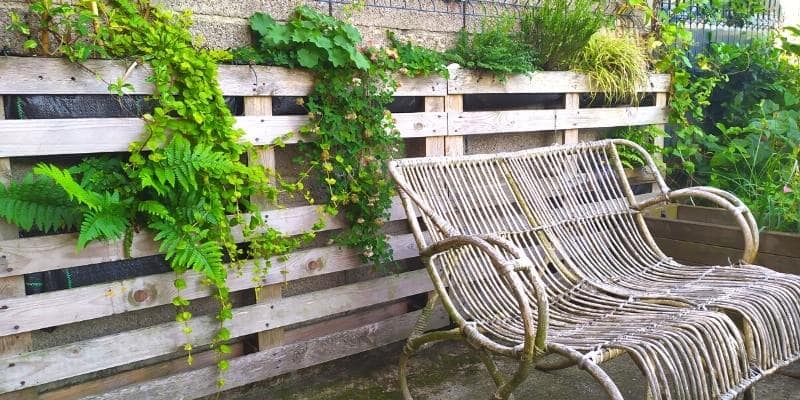
An unsightly concrete-block wall is hidden behind planted pallets to create a small relaxation corner
Ingrid’s tips:
- I chose not to close underside of each planter with a board, to make drainage of watering easier. Also, that board would be likely to rot quickly in contact with moisture.
- I use woven weed-control fabric because it lets excess water drain away while preventing plant roots from passing through.
- If possible, don’t place pallet directly on ground; fix it to wall at least 10 cm above soil level. By raising it, you avoid underside of pallet remaining damp from rain and watering, which could quickly rot wood. This extends its lifespan. It also makes terrace cleaning easier.
Which plants to choose for a pallet planting?
- On a pallet, space for plants is very limited. They have little substrate, as in a traditional planter. Choose plants suited to small spaces and with limited growth.
- You can create a small vertical kitchen garden, adding strawberry plants, small lettuces, cherry tomatoes, beans and small peas.
- Pallets are perfectly suited to aromatic plants, such as thyme, oregano, chives, basil and mint.
- In Mediterranean regions, prefer succulents, fleshy plants or cacti for their resistance to heat and summer drought.
- For a cascade of flowers, plant beautiful annuals such as petunias, pansies, geraniums, a Fuchsia 'Dark Eyes' or summer-blooming bulbs like Begonia pendulata odorata 'mix'.
- For perennials, install a pretty wall bellflower, small ornamental grasses, ivy, houseleeks, sedums, iberis or a fern.
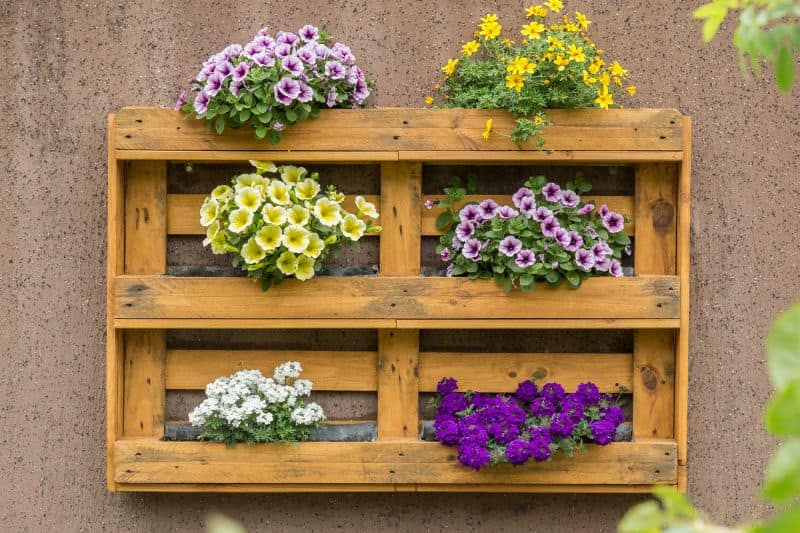
Beautiful annuals for long summer flowering on a wooden pallet
Plant and pallet maintenance
- As with a classic planter, potting compost tends to dry out very quickly, even in shade. In summer, you will therefore need to water daily, especially in full sun.
- Renew substrate each spring to provide essential nutrients for plants.
- To extend pallet lifespan, consider applying a coat of wood stain or paint.

A small vertical herb garden within reach on a wooden pallet































![[planters type="palette" design="homemade"] [planters type="palette" design="DIY"]](https://en.promessedefleurs.eu/blogwp/wp-content/uploads/2022/08/fabriquer-jardiniere-en-palette.jpg)
Comments